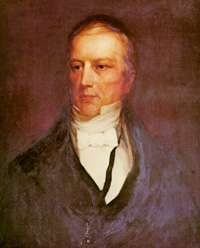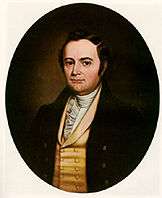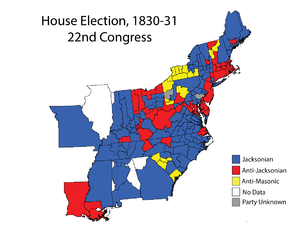United States House of Representatives elections, 1830
| | |||||||||||||||||||||||||||||||||||||||||||||||||||||||||||||||
| |||||||||||||||||||||||||||||||||||||||||||||||||||||||||||||||
| |||||||||||||||||||||||||||||||||||||||||||||||||||||||||||||||
|
| |||||||||||||||||||||||||||||||||||||||||||||||||||||||||||||||
| |||||||||||||||||||||||||||||||||||||||||||||||||||||||||||||||
In the United States House of Representatives elections of 1830 the supporters of President Andrew Jackson lost ten seats, but managed to maintain control of the chamber amidst the growth of two new opposition movements.
The brass style of Congress during the administration of Andrew Jackson caused a number of Americans to become dissatisfied with the government and both of the major parties. Anger over the Tariff of 1828 also provided a major issue, particularly in the agricultural South. The Democrats remained firmly in control of the House, but lost several seats, as did the minority Anti-Jacksonians. The Anti-Masonic Party, an aspiring third party which was based on a single issue (distrust of Freemasonry), was actually able to gain a dozen seats, and four South Carolina Congressman who called themselves Nullifiers (based on the principle of states' rights) were also elected. Thus, this was the first election in the House where both major parties lost seats at the same time; this would not occur again until the 1854 elections.
Election summaries
| 126 | 4 | 17 | 66 |
| Jacksonian | N | AM | Anti-Jacksonian |
| State | Type | Date | Total seats |
Jacksonian | Anti-Jacksonian | Anti-Masonic | Nullifier | ||||
|---|---|---|---|---|---|---|---|---|---|---|---|
| Seats | Change | Seats | Change | Seats | Change | Seats | Change | ||||
| Delaware | At-large | November 13, 1830 | 1 | 0 | 1 | 0 | 0 | ||||
| Georgia | At-large | October 4, 1830 | 7 | 7 | 0 | 0 | 0 | ||||
| Louisiana | District (3) | July 5–7, 1830 | 3 | 1 | 2 | 0 | 0 | ||||
| Maine | District (7) | September 13, 1830 | 7 | 6 | 1 | 0 | 0 | ||||
| Massachusetts | District (13) | November 1, 1830 | 13 | 0 | 13 | 0 | 0 | ||||
| Mississippi | At-large | August 2–3, 1830 | 1 | 1 | 0 | 0 | 0 | ||||
| New Jersey | At-large | November 6, 1830 | 6 | 0 | 6 | 0 | 0 | ||||
| New York | District (30[Note 1]) | November 1–3, 1830 | 34 | 23 | 3 | 8 | 0 | ||||
| Ohio | District (14) | October 12, 1830 | 14 | 6 | 8 | 0 | 0 | ||||
| Pennsylvania | District (18[Note 2]) | October 12, 1830 | 26 | 17 | 2 | 7 | 0 | ||||
| South Carolina | District (9) | October 11–12, 1830 | 9 | 5 | 0 | 0 | 4 | ||||
| Vermont | District (5) | September 6, 1830 | 5 | 0 | 3 | 2 | 0 | ||||
| 1831 elections | |||||||||||
| Alabama | District (3) | August 1, 1831 | 3 | 3 | 0 | 0 | 0 | ||||
| Connecticut | At-large | April 14, 1831 | 6 | 0 | 6 | 0 | 0 | ||||
| Illinois | At-large | August 1, 1831 | 1 | 1 | 0 | 0 | 0 | ||||
| Indiana | District (3) | August 5, 1831 | 3 | 3 | 0 | 0 | 0 | ||||
| Kentucky | District (12) | August 1, 1831 | 12 | 8 | 4 | 0 | 0 | ||||
| Maryland | District (8[Note 3]) | October 3, 1831 | 9 | 4 | 5 | 0 | 0 | ||||
| Missouri | At-large | August 2, 1831 | 1 | 1 | 0 | 0 | 0 | ||||
| New Hampshire | At-large | March 8, 1831 | 6 | 6 | 0 | 0 | 0 | ||||
| North Carolina | District (13) | August 11, 1831 | 13 | 11 | 2 | 0 | 0 | ||||
| Rhode Island | At-large | August 23, 1831 | 2 | 0 | 2 | 0 | 0 | ||||
| Tennessee | District (9) | August 4–5, 1831 | 9 | 8 | 1 | 0 | 0 | ||||
| Virginia | District (22) | April, 1831 | 22 | 17 | 5 | 0 | 0 | ||||
| Total | 213 | 126 59.2% |
|
66 31.0% |
|
17 8.0% |
|
4 1.9% |
| ||
Complete results
Alabama
| District | Incumbent | Party | First elected |
Result | Candidates |
|---|---|---|---|---|---|
| Alabama 1st Known as the Northern District |
Clement C. Clay | Jacksonian | 1829 | Re-elected | √ Clement C. Clay (J) 100.00% |
| Alabama 2nd Known as the Middle District |
Robert E. B. Baylor | Jacksonian | 1825 | Lost re-election Jacksonian hold |
√ Samuel W. Mardis (J) 41.58% Jesse W. Garth (NR) 35.51% Robert E. B. Baylor (J) 22.92% |
| Alabama 3rd Known as the Southern District |
Dixon Hall Lewis | Jacksonian | 1829 | Re-elected | √ Dixon Hall Lewis (J) 57.64% John Murphy (J) 42.36% |
Connecticut
| District | Incumbent | Party | First elected |
Result | Candidates |
|---|---|---|---|---|---|
| Connecticut At-Large 6 seats on a general ticket |
Ralph I. Ingersoll | Adams | 1825 | Re-elected | √ Noyes Barber (AJ) 14.55% √ Ralph I. Ingersoll (AJ) 14.54% √ Jabez W. Huntington (AJ) 13.33% √ William W. Ellsworth (AJ) 13.31% √ William L. Storrs (AJ) 13.09% √ Ebenezer Young (AJ) 1.93% Isaac Toucey (J) 7.04% Simeon Minor (J) 7.04% Elisha Halsey (J) 6.33% William Hollabird (J) 4.88% Thaddeus Betts 3.95% |
| Noyes Barber | Adams | 1821 | Re-elected | ||
| Ebenezer Young | Adams | 1829 | Re-elected | ||
| Jabez W. Huntington | Adams | 1829 | Re-elected | ||
| William L. Storrs | Adams | 1829 | Re-elected | ||
| William W. Ellsworth | Adams | 1829 | Re-elected |
Delaware
| District | Incumbent | Party | First elected |
Result | Candidates |
|---|---|---|---|---|---|
| Delaware At-Large | Kensey Johns | Anti-Jacksonian | 1827 (Special) | Retired Anti-Jacksonian hold |
√ John J. Milligan (AJ) 52.68% Henry M. Ridgely (D) 47.32% |
Pennsylvania
| District | Incumbent | Party | First elected |
Result | Candidates[1][Note 4] |
|---|---|---|---|---|---|
| Pennsylvania 1 | Joel B. Sutherland | Jacksonian | 1826 | Re-elected | Joel B. Sutherland (J) 66.2% Stephen Simpson (AJ) 33.8% |
| Pennsylvania 2 | Joseph Hemphill | Jacksonian | 1800 1828 |
Retired Jacksonian hold |
Henry Horn (J) 55.6% Daniel W. Coxe (AJ) 44.4% |
| Pennsylvania 3 | Daniel H. Miller | Jacksonian | 1822 | Lost re-election Anti-Jacksonian gain |
John G. Watmough (AJ) 54.1% Daniel H. Miller (J) 45.9% |
| Pennsylvania 4 Plural district with 3 seats |
James Buchanan | Jacksonian | 1820 | Retired Anti-Masonic gain |
William Hiester (AM) 52.4% Joshua Evans, Jr. (J) 50.4% David Potts, Jr. (AM) 49.1% Edward Darlington (AM) 49.0% Samuel Boyd (J) 47.3% Archibald T. Dick (J) 37.1% Samuel Edwards (F) 14.6% |
| Joshua Evans, Jr. | Jacksonian | 1828 | Re-elected | ||
| George G. Leiper | Jacksonian | 1828 | Retired Anti-Masonic gain | ||
| Pennsylvania 5 | John B. Sterigere | Jacksonian | 1826 | Retired Jacksonian hold |
Joel K. Mann (J) 56.4% John Freedly (AM) 43.6% |
| Pennsylvania 6 | Innis Green | Jacksonian | 1826 | Retired Jacksonian hold |
John C. Bucher (J) 54.4% Valentine Hummel (AJ) 45.6% |
| Pennsylvania 7 Plural district with 2 seats |
Joseph Fry, Jr. | Jacksonian | 1826 | Retired Jacksonian hold |
Henry A. P. Muhlenberg (J) 58.3% Henry King (J) 55.0% John Bentenman (AM) 44.2% Walter C. Livingston (AM) 42.5% |
| Henry A. P. Muhlenberg | Jacksonian | 1828 | Re-elected | ||
| Pennsylvania 8 Plural district with 2 seats |
Peter Ihrie, Jr. | Jacksonian | 1829 (special) | Re-elected | Peter Ihrie, Jr. (J) 61.0% Samuel A. Smith (J) 48.1% Lewis A. Coryell (D?) 33.4% Christian J. Hutter (D?) 29.7% James M. Porter (AJ) 18.4% Stephen Brock (AJ) 9.4% |
| Samuel A. Smith | Jacksonian | 1829 (special) | Re-elected | ||
| Pennsylvania 9 Plural district with 3 seats |
Philander Stephens | Jacksonian | 1828 | Re-elected | Lewis Dewart (D[Note 5]) 99.0% Philander Stephens (J) 69.6% James Ford (J) 68.4% John Burrows (AJ) 32.3% George Walker (AJ) 30.7% |
| James Ford | Jacksonian | 1828 | Re-elected | ||
| Alem Marr | Jacksonian | 1828 | Retired Jacksonian hold | ||
| Pennsylvania 10 | Adam King | Jacksonian | 1826 | Re-elected | Adam King (J) 58.6% William McIlvine (AJ) 41.4% |
| Pennsylvania 11 Plural district with 2 seats |
Thomas H. Crawford | Jacksonian | 1828 | Re-elected | Thomas H. Crawford (J) 60.1% William Ramsey (J) 59.2% Jacob Alter (AM) 40.5% Robert Smith (AM) 40.1% |
| William Ramsey | Jacksonian | 1826 | Re-elected[Note 6] | ||
| Pennsylvania 12 | John Scott | Jacksonian | 1828 | Lost re-election Anti-Masonic gain |
Robert Allison (AM) 55.1% John Scott (J) 44.9% |
| Pennsylvania 13 | Chauncey Forward | Jacksonian | 1826 | Retired Anti-Jacksonian gain |
George Burd (AJ) 50.2% David Mann (AM) 48.5% Reynolds[Note 7] 1.3% |
| Pennsylvania 14 | Thomas Irwin | Jacksonian | 1828 | Lost re-election Anti-Masonic gain |
Andrew Stewart (AM) 54.3% Thomas Irwin (J) 45.7% |
| Pennsylvania 15 | William McCreery | Jacksonian | 1828 | Lost re-election Anti-Masonic gain |
Thomas M. T. McKennan (AM) 52.1% William McCreery (J) 47.9% |
| Pennsylvania 16 Plural district with 2 seats |
John Gilmore | Jacksonian | 1828 | Re-elected | Harmar Denny (AM) 55.2% John Gilmore (J) 41.6% Robert T. Stewart (J) 35.7% William Ayers (AM) 35.4% Walter Forward (AM) 32.2% |
| Harmar Denny | Anti-Masonic | 1829 (special) | Re-elected | ||
| Pennsylvania 17 | Richard Coulter | Jacksonian | 1826 | Re-elected | Richard Coulter (J) 63.5% Thomas Pollock (AM) 26.5% |
| Pennsylvania 18 | Thomas H. Sill | Anti-Jacksonian | 1826 (special) 1828 |
Retired Anti-Masonic gain |
John Banks (AM) 57.1% Thomas S. Cunningham (J) 42.9% |
In the 11th district, William Ramsey (J) died on September 29, 1831, before the first meeting of the 22nd Congress. A special election was held on November 22, 1831 to fill the resulting vacancy, electing Robert McCoy (J)[2]
See also
Notes
- ↑ Includes 3 plural districts
- ↑ Includes 6 plural districts
- ↑ Includes 1 plural district
- ↑ For plural districts, percent is based on assumption that each voter cast as many votes as there are seats
- ↑ Ran on joint Jacksonian/Anti-Jacksonian ticket
- ↑ Died before the start of the 22nd Congress
- ↑ Source did not give full name
References
Bibliography
- Dubin, Michael J. (March 1, 1998). United States Congressional Elections, 1788-1997: The Official Results of the Elections of the 1st Through 105th Congresses. McFarland and Company. ISBN 978-0786402830.
- Martis, Kenneth C. (January 1, 1989). The Historical Atlas of Political Parties in the United States Congress, 1789-1989. Macmillan Publishing Company. ISBN 978-0029201701.
- Moore, John L., ed. (1994). Congressional Quarterly's Guide to U.S. Elections (Third ed.). Congressional Quarterly Inc. ISBN 978-0871879967.
- "Party Divisions of the House of Representatives* 1789–Present". Office of the Historian, House of United States House of Representatives. Retrieved January 21, 2015.
External links
- Office of the Historian (Office of Art & Archives, Office of the Clerk, U.S. House of Representatives)


